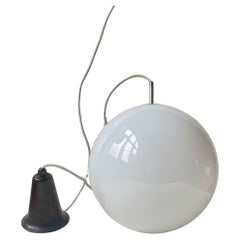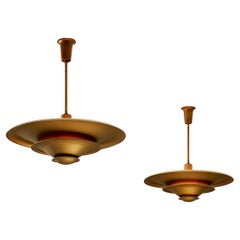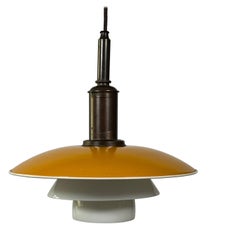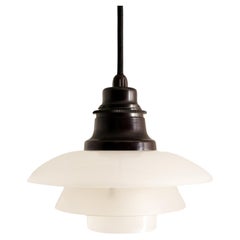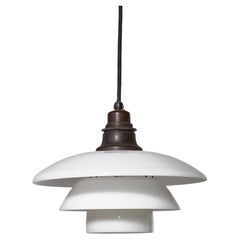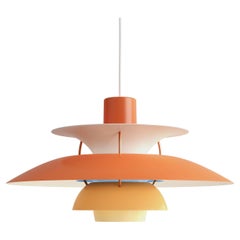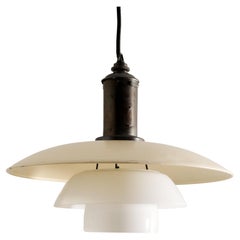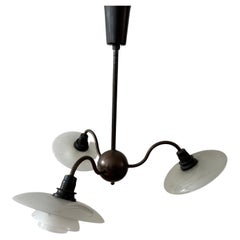1930s Chandeliers and Pendants
11
to
10
1
11
11
11
8
1
1
1
189
372
1
130
47
1
11
44
53
32
8
2
Height
to
Width
to
10
2
1
1
9
8
5
5
4
11
11
11
572
27
27
24
21
Period: 1930s
Creator: Louis Poulsen
Louis Poulsen Functionalist Globe Pendant Lamp in White Opaline Glass, 1930s
Located in Esbjerg, DK
A rare version of the LP 18064-0104 by Louis Poulsen in Denmark. This one featuring a bakelit top and matching bakelit canopy. Made during the 1930s and often falsely attributed Vilh...
Category
Danish Bauhaus Vintage 1930s Chandeliers and Pendants
Materials
Bakelite, Opaline Glass
Rare 1930s Louis Poulsen Pair of Ceiling Lights in Bronze Painted Metal
Located in Waalwijk, NL
Louis Poulsen, pair of pendants, model 'A-Lamp', painted metal, Denmark, 1930s
Dating back to the 1930s, these lighting objects made by Louis Poulsen are a rare occurrence. The mult...
Category
Danish Art Deco Vintage 1930s Chandeliers and Pendants
Materials
Metal
1930s Poul Henningsen PH Model 3/2 Pendant Lamp for Louis Poulsen
Located in Oakland, CA
Early 1930s Poul Henningsen 3/2 pendant lamp for Louis Poulsen & Co. of Denmark. Copper and glass construction, the top shade in a lacquered mustard colored copper shade and the bott...
Category
Danish Scandinavian Modern Vintage 1930s Chandeliers and Pendants
Materials
Metal
Early Yellow Poul Henningsen "PH 2/2" Mid Century Pendant by Louis Poulsen 1930s
Located in Stockholm, SE
Very rare small mid century "PH 2/2" ceiling pendant in patinated brass, bakelite and original yellow opaline glass shades by Poul Henningsen produced by Louis Poulsen Denmark, 1930s...
Category
Danish Scandinavian Modern Vintage 1930s Chandeliers and Pendants
Materials
Brass
Early White Poul Henningsen "PH 2/2" Mid Century Pendant by Louis Poulsen 1930s
Located in Stockholm, SE
Very rare small mid century "PH 2/2" ceiling pendant in patinated brass, bakelite and original white opaline glass shades by Poul Henningsen produced by Louis Poulsen Denmark, 1930s....
Category
Danish Scandinavian Modern Vintage 1930s Chandeliers and Pendants
Materials
Brass
Louis Poulsen "PH-lamp" 3/3 Pendant by Poul Henningsen, Patented, Denmark, 1930s
Located in Odense, DK
Early original "PH-lamp" pendant made in the 1930s at Louis Poulsen, Copenhagen. This is the "3/3" sized pendant with original opaline shades and bakelite socket house as invented by...
Category
Danish Scandinavian Modern Vintage 1930s Chandeliers and Pendants
Materials
Glass, Bakelite
Hanging copper Poul Henningsen PH4/4 1930's original Louis Poulsen Denmark Rare
Located in Forest, BE
Spectacular copper and brass nickeled suspension lamp made in the 1930s at the famous Louis Poulsen factory. The lamp come in few parts which includes 3 copper shades. Easy to fix install. The lamp remain in excellent condition and is ready to be used as she got a new cable in cotton. You can see lots of patina and traces of time. It becomes really hard to find a good PH lamps these days.
_____________________________________________________________
Poul Henningsen est le fils illégitime de l'auteure Agnès Henningsen et de l'écrivain satirique Carl Ewald. Il a passé une enfance heureuse dans une maison moderne qui a été souvent visitée par les intellectuels de la région. Entre 1911 et 1917, Poul Henningsen suit une formation d’architecte sans pourtant en obtenir le diplôme.
Durant les années 1920, Poul Henningsen a fait sa percée littéraire. Il a édité la revue Kritisk Revy (1926-1928, "Examen critique») dans laquelle lui et ses collègues méprisent le style ancien et le conservatisme culturel, reliant ainsi les thématiques politiques de l'époque . En même temps, il débute comme écrivain pour une revue sur les bienfaits d'une vie simple, en harmonie avec la nature et une sexualité plus libre . Il était l'homme qui a fait des revues danoises des armes politiques au service de aile gauche sans abandonner son caractère de divertissement (la soi-disant PH-revues 1929-1932).
En 1933, il édita son ouvrage le plus célèbre Hvad med Kulturen? ("Qu'en est-il de la culture ?") Une critique polémique, audacieuse et urgente de la vie culturelle danoise avec son snobisme et sa nostalgie du passé, en dépit de tous les efforts de la percée du modernisme. Il a essayé de faire un parallèle entre la pruderie, moralisateurs et penchants fascistes; il a également accusé les sociaux-démocrates de manquer d'une ligne culturelle ferme et conséquente. Ce livre ainsi que ses activités dans son ensemble lui ont donné une réputation de semi-communiste ("compagnon de route"). Dans cette période, il se tenait en fait proche des communistes sans les rejoindre. Il a participé à la propagande anti-fasciste, en essayant toujours de faire des connexions entre la culture et la politique.
Parmi ses autres initiatives durant cette période, il y a eu Danmarksfilmen en 1935, (en français : Le Film du Danemark) aussi connu comme Danmarksfilm PH. C'est un film sans prétention et non traditionnel dépeignant la vie contemporaine dans le Danemark d'une manière vivante et un peu irrespectueuse dans lequel les visuels sont saccadés par les rythmes de jazz. Il a été condamné et déchiré par la plupart des critiques, mais il est plus tard réhabilité et est devenu l'un des classiques des films documentaires danois. Il a également écrit des manuscrits de films.
Pendant la Seconde Guerre mondiale et l'Occupation allemande du Danemark il a gardé un profil bas et s'est enfui vers la Suède en 1943. Après la guerre, il s'est dissocié du communisme qui lui reprochant son humanitarisme de façade dans son attitude lors de l'accord conclu avec les nazis ainsi que pour son scepticisme croissant au sujet de l'Union soviétique et à bien des égards, il a été isolé. Cependant, il a continué à écrire et à débattre, et au cours des années 1960, la nouvelle génération à de nombreux égards a fait de lui une sorte de gourou. Dans ses dernières années, il est devenu un membre de l'Académie danoise et a soutenu le nouveau mouvement des consommateurs.
À bien des égards, Poul Henningsen est l'homme qui a achevé les travaux de Georg Brandes...
Category
Danish Scandinavian Modern Vintage 1930s Chandeliers and Pendants
Materials
Brass, Copper, Nickel
PH 3/2 Pendant by Poul Henningsen and Louis Poulsen
Located in Lejre, DK
PH 3/2 pendant designed by Poul Henningsen and manufactured by Louis Poulsen. The lamp is of white opaline glass and black chromed.
Category
Danish Scandinavian Modern Vintage 1930s Chandeliers and Pendants
Materials
Opaline Glass
Poul Henningsen 3/2 Table Lamp of Patinated Brass, Pat. Appl. 1926-1928, Denmark
Located in Esbjerg, DK
Poul Henningsen PH 2/2 pendant lamp. Shade of white and red laquered copper. Middle and bottom shade of frosted glass.
Marked Patented, made by Louis poulsen in the 1930s.
Category
Danish Scandinavian Modern Vintage 1930s Chandeliers and Pendants
Materials
Brass, Copper
Ph 2/1 Stem Fitting Of Chrome by Poul Henningsen From 1980s
Located in Lejre, DK
This PH 2/1 stem fitting, designed by the renowned Poul Henningsen and manufactured by Louis Poulsen in the 1980s, epitomizes the iconic Danish lighting design of the era. Crafted fr...
Category
Danish Mid-Century Modern Vintage 1930s Chandeliers and Pendants
Materials
Metal
Poul Henningsen Kuglekrone, 1930s
Located in Valby, 84
Rare and important Poul Henningsen kuglekrone chandelier made by Louis Poulsen in Denmark in the 1930’s.
The frame is made of darkend brass with original acid stained glass and black Bakelite.
Poul Henningsen (September 9, 1894 in Ordrup – January 31, 1967 in Hillerød) was a Danish lamp designer, architect, revue writer, film director and social activist known by the initials PH. He was the son of the writer Agnes Henningsen and the stepson of MA, vice consul Mads Henningsen. His biological father was the writer Carl Ewald.
PH had his own design studio from 1919, where i.a. the architects Hans Hansen and Mogens Voltelen worked on the clean drawing of the PH lamps. PH thought that electric bulbs cast an impossible light - either it was far too bright, or screens swallowed most of the light. He wanted a lampshade that sent the light out into the room at its full strength without dazzling. The PH lamp's three screens ensure that. He experimented in his terraced house until the lamp up in the ceiling, where the walls were painted black. A pram could be driven back and forth on rails. On the wagon, a candle stood on a cardboard plate and shone on a piece of paper with a grease stain through which the light shone. PH called it a photometer and used it for thousands of measurements of light strength and curves.
The breakthrough came when a mutual friend, architect Thorkild Henningsen, introduced him to Sophus Kaastrup Olsen, director of Louis Poulsen & Co. This was the start of a lifelong collaboration. Kaastrup Olsen had some lighting fixtures manufactured and sent them to the international exhibition Arts décoratifs et industriels modernes in Paris in 1925. PH won top prizes in all six classes of lighting fixtures.
Forum was inaugurated in 1926 with a car exhibition where the PH lamp with glass shades made its debut. About PH's lamps that illuminated the room, B.T. wrote: "- the white birds that flew through the giant hall". Success was assured and PH's dream fulfilled: he had created a product that could be mass produced and he became a wealthy man.
His greatest success was the PH5 – the one we know as the PH lamp (with metal shades), but it was only launched in 1958. He also designed the Koglen, the Kuglen and the Charlottenborg Pendlen, which all hang in Designmuseum Denmark.
He lived off the income from his famous PH lamps and used the freedom it gave him to write revues such as Ølhunden, which was sung by Osvald Helmuth, and Grabe imter blanke ting (Man bind us by mouth and hand...) , which was about the German censorship, and which was sung by Liva Weel. He began collaborations with Bernhard Christensen and Kai Normann Andersen.
Poul Henningsen, in addition to seeing cubism as his style ideal ("the genuine classless art of democracy"), was a functionalist, an atheist, a hater of the church, an advocate of sexual freedom and an opponent of unnecessary ornaments on buildings. Everything had to reflect their function. This is reflected in a number of buildings in Denmark, for which Poul Henningsen was the architect; like his own villa by Gentofte Sø. From 1941 he was architect for the amusement park Tivoli in Copenhagen. At the same time, he took a unique moderate position, because already in his writings in Kritisk Revy he was critical of Bauhaus' "laboratory architecture" and Le Corbusier. He instead recommended a golden mean and thus paved the way for moderate Scandinavian functionalism.
Louis Poulsen, eg. Louis Poulsen Lighting A/S, formerly Louis Poulsen & Co. A/S, is a Danish company that manufactures lamps and lighting designed by well-known designers. Previously, the company also had a wholesale company under the name Louis Poulsen El-teknik, which was acquired by Lemvigh-Müller in 2005. The company was founded in 1874 in Copenhagen by Ludvig R. Poulsen (1846-1906) as a wine import company under the name Copenhagen Direct Vin-Import-Kompagni. The company closed in 1878, but continued in the wholesale business. In 1892 - the same year that Copenhagen got its first and the country's second electricity plant - Ludvig R. Poulsen established a business selling tools and electrical articles in Istedgade 1 on Vesterbro in Copenhagen. In 1896, Ludvig R. Poulsen employed his nephew, Louis Poulsen (1871-1934), in the company.
In 1906, Ludvig R. Poulsen died, who was succeeded by his nephew as director. In 1908 he moved the headquarters to Nyhavn 11, and in 1911 he admitted Sophus Kaastrup-Olsen (1884-1938) as a partner in the firm, which was then named Louis Poulsen & Co. In 1914 the company's first catalog was published, and in 1917 Sophus Kaastrup-Olsen Louis Poulsen bought out the company for DKK 10,000 and thus became sole owner of Louis Poulsen & Co. In 1918, the turnover reached 5 million. DKK In 1933, Louis Poulsen & Co. opened. a department in Aarhus.
From 1938, the company, which was transformed into a limited company on 1 November 1939, was led by civil engineer Emun Rager (1884-1959) as managing director, as Kaastrup-Olsen died that year.
When buying Laur. Henriksen's Metalware factory in 1941 went to Louis Poulsen & Co. A/S itself into the production of lighting fixtures. The magazine LP-NYT was launched the same year with Poul Henningsen as editor.
A newly constructed building on Sluseholmen in Copenhagen was inaugurated in 1959 and was partly used for the assembly of fluorescent light fixtures and partly for electrical wholesale storage. In the same year, Jens Kaastrup-Olsen became managing director after Emun Rager.
In 1964, the wholesale section was expanded by the acquisition of A/S Classen-Smidth, whereby the company gained branches in Odense and Vejle, and in 1965 Laur changed. Henriksens Metalvarefabrik name for Elpefa A/S, which moved to a newly built production hall on Sluseholmen, where all production and assembly of fittings were brought together. In 1967, I/S El-Salg was established.
In 1976, Jens Kaastrup-Olsen died and was succeeded as managing director by Hans Cordes. The following year, the metalware production, which was previously an independent company called Elpefa A/S, was merged with Louis Poulsen & Co. A/S. Louis Poulsen's B shares were listed on the Copenhagen Stock Exchange, and a shareholder agreement was concluded between the heirs in 1977 to ensure that the company remained in Danish hands.
1981 Louis Poulsen & Co. bought A/S electrical wholesale section in S.C. Sørensen and thereby got eight electricity wholesale departments included in the purchase. In 1984, Elpefa Handels- og ingeniersfirma was established, in 1985 JO-EL A/S, and in 1987 the group's turnover reached DKK 1 billion. DKK
In 1989, Louis Poulsen & Co. acquired A/S Skandia Havemann's El A/S, in 1990 the Danish subsidiary Lightmakers A/S was established, and in 1995 the electrical wholesale section established a special department for telecommunications and data under the name Louis Poulsen Kommunikation. At the same time, the e-commerce system eLPc was introduced.
In 1997, Erik Holm became managing director, and in the same year the Lighting Section bought the English company Outdoor Lighting Ltd. The measuring instrument section of Elpefa A/S was separated in 1998 as an independent limited company under the name ELMA A/S. The electrical engineering section simultaneously bought Norsk Elektro Teknikk ASA and Nordisk Elektro Teknik AB.
The shareholders' agreement of 1977 led in the 1990s to several family feuds and lawsuits, but in 1999 an agreement was reached. The family allowed themselves to be bought out, while the company remained in Danish ownership. The new owners were the investment consortium Polaris and HD Invest. After the change of ownership, the Louis Poulsen shares were delisted on the Copenhagen Stock Exchange. In the wake of the company's 125th anniversary in 1999, the former A-shareholders and the new owners of the Louis Poulsen Group established a new Danish lighting...
Category
Danish Scandinavian Modern Vintage 1930s Chandeliers and Pendants
Materials
Brass
Related Items
Poul Henningsen PH 5 Pendant for Louis Poulsen in Rose
Located in Glendale, CA
Poul Henningsen PH 5 pendant for Louis Poulsen in rose. Poul Henningsen introduced his iconic PH 5 pendant light in 1958. Six decades later, the PH 5 remains the bestselling design in the Louis Poulsen's portfolio. The PH 5's painted metal shades brilliantly distribute light to create glare–free illumination. Executed in spun aluminium shades...
Category
Danish Scandinavian Modern 1930s Chandeliers and Pendants
Materials
Aluminum
Poul Henningsen PH 5 Pendant for Louis Poulsen in Orange
Located in Glendale, CA
Poul Henningsen PH 5 pendant for Louis Poulsen in orange. Poul Henningsen introduced his iconic PH 5 pendant light in 1958. Six decades later, the PH 5 remains the bestselling design in the Louis Poulsen's portfolio. The PH 5's painted metal shades brilliantly distribute light to create glare–free illumination. Executed in spun aluminium shades...
Category
Danish Scandinavian Modern 1930s Chandeliers and Pendants
Materials
Aluminum
Poul Henningsen Glass PH 3½-3 Pendant for Louis Poulsen in Black Metallized
Located in Glendale, CA
Poul Henningsen Glass PH 3½-3 Pendant for Louis Poulsen in Black Metallized
Executed in white opal glass and choice of brass, chrome or black...
Category
Danish Scandinavian Modern 1930s Chandeliers and Pendants
Materials
Metal
Poul Henningsen PH 5 Pendant for Louis Poulsen in All White
Located in Glendale, CA
Poul Henningsen PH 5 pendant for Louis Poulsen in all white. Poul Henningsen introduced his iconic PH 5 pendant light in 1958. Six decades later, the PH 5 remains the bestselling des...
Category
Danish Scandinavian Modern 1930s Chandeliers and Pendants
Materials
Aluminum
Louis Poulsen PH5 Mini Pendant Lamp by Poul Henningsen
Located in New York, NY
Poul Henningsen was born in Copenhagen by the famous Danish actress Agnes Henningsen. He never graduated as an architect, but studied at The Technical School at Frederiksberg, Denmar...
Category
Danish Modern 1930s Chandeliers and Pendants
Materials
Metal
Poul Henningsen PH 5 Pendant for Louis Poulsen in Classic White
Located in Glendale, CA
Poul Henningsen PH 5 Pendant for Louis Poulsen in Classic White. Poul Henningsen introduced his iconic PH 5 pendant light in 1958. Six decades later, the PH 5 remains the bestselling...
Category
Danish Scandinavian Modern 1930s Chandeliers and Pendants
Materials
Aluminum
Poul Henningsen PH Septima Pendant for Louis Poulsen
Located in Glendale, CA
Poul Henningsen PH Septima pendant for Louis Poulsen. Designed in 1928, the PH Septima is regarded as one of Poul Henningsen’s most refined pendants. Based ...
Category
Danish Mid-Century Modern 1930s Chandeliers and Pendants
Materials
Glass
Poul Henningsen PH 3½-3 Pendants for Louis Poulsen
Located in Glendale, CA
The PH 3½-3 pendants are an addition to the Louis Poulsen PH collection and are based on Poul Henningsen's original drawings from the late 1920s and early 1930s, featuring his renown...
Category
Danish Scandinavian Modern 1930s Chandeliers and Pendants
Materials
Aluminum, Copper
Poul Henningsen PH 5 Brass Pendant for Louis Poulsen
Located in Glendale, CA
Poul Henningsen PH 5 brass pendant for Louis Poulsen. Poul Henningsen introduced his iconic PH 5 pendant light in 1958. To celebrate, Louis Poulsen is puttin...
Category
Danish Scandinavian Modern 1930s Chandeliers and Pendants
Materials
Brass, Aluminum
Arlt Deco Opaline Glass Pendant, 1930s
Located in Praha, CZ
Very good condition: polished, rewired.
Glass without any damage.
Central rod can be shortened on request.
1x100W, E25-E27 bulb
US wiring compatible.
Category
Czech Art Deco Vintage 1930s Chandeliers and Pendants
Materials
Nickel
Louis Poulsen, Medium Metal Pendant Light by Poul Henningsen
Located in Saint-Ouen, FR
Louis Poulsen, medium metal pendant light by Poul Henningsen.
Size: Width x height x length (mm)
300 x 163 x 300, 0.9 kg
Material: Matte lacquered aluminum. Struts: Purple, rolled aluminum...
Category
Danish Modern 1930s Chandeliers and Pendants
Materials
Metal
White Scandinavian PH5 Pendant by Poul Henningsen for Louis Poulsen
Located in Vienna, AT
This iconic Scandinavian Modern Pendant Light was Designed by Poul Henningsen for Louis Poulsen Denmark. It provides 100% glare-free light. Poul Henningsen developed the PH 5 in 1958...
Category
Danish Scandinavian Modern Vintage 1930s Chandeliers and Pendants
Materials
Aluminum
Previously Available Items
Poul Henningsen "PH-3.5 / 3" Metal and Glass Pendant by Louis Poulsen, 1930s
Located in Stockholm, SE
Very rare mid century and iconic pendant model "PH 3,5 / 3" in white lacquered metal and opaline glass shades designed by Poul Henningsen and produced by Louis Poulsen, Denmark 1930s...
Category
Danish Scandinavian Modern Vintage 1930s Chandeliers and Pendants
Materials
Metal
Poul Henningsen Kuglekrone, 1930s
Located in Valby, 84
Rare and important Poul Henningsen kuglekrone chandelier made by Louis Poulsen in Denmark in the 1930’s.
The frame is made of darkend brass with original acid stained glass and black Bakelite.
Poul Henningsen (September 9, 1894 in Ordrup – January 31, 1967 in Hillerød) was a Danish lamp designer, architect, revue writer, film director and social activist known by the initials PH. He was the son of the writer Agnes Henningsen and the stepson of MA, vice consul Mads Henningsen. His biological father was the writer Carl Ewald.
PH had his own design studio from 1919, where i.a. the architects Hans Hansen and Mogens Voltelen worked on the clean drawing of the PH lamps. PH thought that electric bulbs cast an impossible light - either it was far too bright, or screens swallowed most of the light. He wanted a lampshade that sent the light out into the room at its full strength without dazzling. The PH lamp's three screens ensure that. He experimented in his terraced house until the lamp up in the ceiling, where the walls were painted black. A pram could be driven back and forth on rails. On the wagon, a candle stood on a cardboard plate and shone on a piece of paper with a grease stain through which the light shone. PH called it a photometer and used it for thousands of measurements of light strength and curves.
The breakthrough came when a mutual friend, architect Thorkild Henningsen, introduced him to Sophus Kaastrup Olsen, director of Louis Poulsen & Co. This was the start of a lifelong collaboration. Kaastrup Olsen had some lighting fixtures manufactured and sent them to the international exhibition Arts décoratifs et industriels modernes in Paris in 1925. PH won top prizes in all six classes of lighting fixtures.
Forum was inaugurated in 1926 with a car exhibition where the PH lamp with glass shades made its debut. About PH's lamps that illuminated the room, B.T. wrote: "- the white birds that flew through the giant hall". Success was assured and PH's dream fulfilled: he had created a product that could be mass produced and he became a wealthy man.
His greatest success was the PH5 – the one we know as the PH lamp (with metal shades), but it was only launched in 1958. He also designed the Koglen, the Kuglen and the Charlottenborg Pendlen, which all hang in Designmuseum Denmark.
He lived off the income from his famous PH lamps and used the freedom it gave him to write revues such as Ølhunden, which was sung by Osvald Helmuth, and Grabe imter blanke ting (Man bind us by mouth and hand...) , which was about the German censorship, and which was sung by Liva Weel. He began collaborations with Bernhard Christensen and Kai Normann Andersen.
Poul Henningsen, in addition to seeing cubism as his style ideal ("the genuine classless art of democracy"), was a functionalist, an atheist, a hater of the church, an advocate of sexual freedom and an opponent of unnecessary ornaments on buildings. Everything had to reflect their function. This is reflected in a number of buildings in Denmark, for which Poul Henningsen was the architect; like his own villa by Gentofte Sø. From 1941 he was architect for the amusement park Tivoli in Copenhagen. At the same time, he took a unique moderate position, because already in his writings in Kritisk Revy he was critical of Bauhaus' "laboratory architecture" and Le Corbusier. He instead recommended a golden mean and thus paved the way for moderate Scandinavian functionalism.
Louis Poulsen, eg. Louis Poulsen Lighting A/S, formerly Louis Poulsen & Co. A/S, is a Danish company that manufactures lamps and lighting designed by well-known designers. Previously, the company also had a wholesale company under the name Louis Poulsen El-teknik, which was acquired by Lemvigh-Müller in 2005. The company was founded in 1874 in Copenhagen by Ludvig R. Poulsen (1846-1906) as a wine import company under the name Copenhagen Direct Vin-Import-Kompagni. The company closed in 1878, but continued in the wholesale business. In 1892 - the same year that Copenhagen got its first and the country's second electricity plant - Ludvig R. Poulsen established a business selling tools and electrical articles in Istedgade 1 on Vesterbro in Copenhagen. In 1896, Ludvig R. Poulsen employed his nephew, Louis Poulsen (1871-1934), in the company.
In 1906, Ludvig R. Poulsen died, who was succeeded by his nephew as director. In 1908 he moved the headquarters to Nyhavn 11, and in 1911 he admitted Sophus Kaastrup-Olsen (1884-1938) as a partner in the firm, which was then named Louis Poulsen & Co. In 1914 the company's first catalog was published, and in 1917 Sophus Kaastrup-Olsen Louis Poulsen bought out the company for DKK 10,000 and thus became sole owner of Louis Poulsen & Co. In 1918, the turnover reached 5 million. DKK In 1933, Louis Poulsen & Co. opened. a department in Aarhus.
From 1938, the company, which was transformed into a limited company on 1 November 1939, was led by civil engineer Emun Rager (1884-1959) as managing director, as Kaastrup-Olsen died that year.
When buying Laur. Henriksen's Metalware factory in 1941 went to Louis Poulsen & Co. A/S itself into the production of lighting fixtures. The magazine LP-NYT was launched the same year with Poul Henningsen as editor.
A newly constructed building on Sluseholmen in Copenhagen was inaugurated in 1959 and was partly used for the assembly of fluorescent light fixtures and partly for electrical wholesale storage. In the same year, Jens Kaastrup-Olsen became managing director after Emun Rager.
In 1964, the wholesale section was expanded by the acquisition of A/S Classen-Smidth, whereby the company gained branches in Odense and Vejle, and in 1965 Laur changed. Henriksens Metalvarefabrik name for Elpefa A/S, which moved to a newly built production hall on Sluseholmen, where all production and assembly of fittings were brought together. In 1967, I/S El-Salg was established.
In 1976, Jens Kaastrup-Olsen died and was succeeded as managing director by Hans Cordes. The following year, the metalware production, which was previously an independent company called Elpefa A/S, was merged with Louis Poulsen & Co. A/S. Louis Poulsen's B shares were listed on the Copenhagen Stock Exchange, and a shareholder agreement was concluded between the heirs in 1977 to ensure that the company remained in Danish hands.
1981 Louis Poulsen & Co. bought A/S electrical wholesale section in S.C. Sørensen and thereby got eight electricity wholesale departments included in the purchase. In 1984, Elpefa Handels- og ingeniersfirma was established, in 1985 JO-EL A/S, and in 1987 the group's turnover reached DKK 1 billion. DKK
In 1989, Louis Poulsen & Co. acquired A/S Skandia Havemann's El A/S, in 1990 the Danish subsidiary Lightmakers A/S was established, and in 1995 the electrical wholesale section established a special department for telecommunications and data under the name Louis Poulsen Kommunikation. At the same time, the e-commerce system eLPc was introduced.
In 1997, Erik Holm became managing director, and in the same year the Lighting Section bought the English company Outdoor Lighting Ltd. The measuring instrument section of Elpefa A/S was separated in 1998 as an independent limited company under the name ELMA A/S. The electrical engineering section simultaneously bought Norsk Elektro Teknikk ASA and Nordisk Elektro Teknik AB.
The shareholders' agreement of 1977 led in the 1990s to several family feuds and lawsuits, but in 1999 an agreement was reached. The family allowed themselves to be bought out, while the company remained in Danish ownership. The new owners were the investment consortium Polaris and HD Invest. After the change of ownership, the Louis Poulsen shares were delisted on the Copenhagen Stock Exchange. In the wake of the company's 125th anniversary in 1999, the former A-shareholders and the new owners of the Louis Poulsen Group established a new Danish lighting...
Category
Danish Scandinavian Modern Vintage 1930s Chandeliers and Pendants
Materials
Brass
Poul Henningsen PH 5/4 Pendant, 1930s
Located in Los Angeles, CA
wonderful early 1930's PH 5/4 Pendant by Poul Henningsen for Louis Poulsen with white enameled metal shade set, patinaed brass bayonet shade holder and bakelite canopy, stamped ph-4 ...
Category
Danish Scandinavian Modern Vintage 1930s Chandeliers and Pendants
Materials
Metal, Brass
Danish Art Deco Uplight Pendant by Louis Poulsen, Model "A-Lamp", Made in 1930s
Located in Odense, DK
Rare collectible Art Deco uplight pendant, made by Louis Poulsen in Denmark.
This elegant light was designed in 1930s and is called "A-Lamp". It featu...
Category
Danish Art Deco Vintage 1930s Chandeliers and Pendants
Materials
Metal
H 23.63 in Dm 19.69 in
Poul Henningsen, "Anchor” Chandelier, Nickel-Plated Metal, Glass, Denmark, 1928
Located in High Point, NC
A rare and sizable "Anchor” chandelier. Designed by Poul Henningsen in 1928. Produced by Louis Poulsen, Denmark.
Features nickel-plated metal and...
Category
Danish Scandinavian Modern Vintage 1930s Chandeliers and Pendants
Materials
Nickel, Metal
PH 2/1 Stem Fitting by Poul Henningsen and Louis Poulsen, 1997
Located in Lejre, DK
PH 2/1 stem fitting designed by Poul Henningsen and manufactured by Louis Poulsen. The stem is in burnished brass. The lamp was made in 1997 to celebrate the 100th year anniversary o...
Category
Danish Scandinavian Modern Vintage 1930s Chandeliers and Pendants
Materials
Brass
Poul Henningsen, 4/4 Pendant Light, Copper, Nickel-Plated Metal, Denmark, 1930s
Located in High Point, NC
One of Poul Henningsens' famous "Patent applied" ceiling pendant lights. Produced by Louis Poulsen in the 1930s. Socket house in nickel-plated metal, lampshades in copper.
Category
Danish Scandinavian Modern Vintage 1930s Chandeliers and Pendants
Materials
Metal, Copper
H 18.9 in Dm 15.75 in
PH 2/1 Stem Fitting by Poul Henningsen and Louis Poulsen, 1997
Located in Lejre, DK
PH 2/1 stem fitting designed by Poul Henningsen and manufactured by Louis Poulsen. The stem is in burnished brass. The lamp was made in 1997 to celebrate the 100th year anniversary o...
Category
Danish Scandinavian Modern Vintage 1930s Chandeliers and Pendants
Materials
Brass
Early Aluminum Pendant Lamp Model A-Lamp by Louis Poulsen, Denmark, 1930s
Located in Berlin, DE
Early and rare pendant lamp, model A-lamp, from 1930s manufactured by Louis Poulsen in Denmark.
Made of aluminum and in a good vintage condition.
1 x E27 socket.
Please note: ...
Category
Danish Scandinavian Modern Vintage 1930s Chandeliers and Pendants
Materials
Aluminum
Poul Henningsen Five-Arm Chandelier, 1930
Located in Los Angeles, CA
Five-arm "Bombardementkrone" chandelier by Poul Henningsen with original orange/yellow tinted matte glass 2/2 shade sets incl. lower bowls on a dark patinaed brass frame with origina...
Category
Danish Mid-Century Modern Vintage 1930s Chandeliers and Pendants
Materials
Brass
Poul Henningsen Ph-3.5/2 Pendant Light, 1930
Located in Los Angeles, CA
Rare 1930s PH-3.5/2 pendant light by Poul Henningsen for Louis Poulsen from 1930 with original shade set, top shade in dark yellow/orange painted metal and two double-layer opaline g...
Category
Danish Scandinavian Modern Vintage 1930s Chandeliers and Pendants
Materials
Metal, Brass, Copper
Poul Henningsen. PH-4 Pendant Light, 1930
Located in Los Angeles, CA
rare 1930s PH-4 pendant light by Poul Henningsen for Louis Poulsen with original shade set, in dark yellow/orange painted metal on an original chrome plated...
Category
Danish Scandinavian Modern Vintage 1930s Chandeliers and Pendants
Materials
Metal, Chrome
Recently Viewed
View AllMore Ways To Browse
Vintage Italian Pair Pendants
Art Nouveau Ceiling
1920 Vintage Chandeliers
Money Safe
American Electrical Lamp
Stilnovo Brass Arm Chandelier
Teardrop Glass Chandelier
Six Bells
1915 Chandelier
Sorensen Brass Lamp
French Art Deco Lighting Schneider
Antique Stone Door
Stilnovo Frosted Glass
Caged Glass Italian
Caged Glass Italy
Vintage Space Age Pendant Light
Amber Ceiling Pendant Light
Antique Metal Pendant Lights
